Introduction
Bat Trang Village, located just 13 kilometers southeast of Hanoi, Vietnam, is a small village with a big reputation. Renowned for its traditional ceramic and pottery craftsmanship, Bat Trang has captured the hearts of tourists from around the world. This article delves into the captivating history of Bat Trang, explores the intricate production process, showcases the diverse range of ceramic products, and highlights the village’s commitment to preserving its cultural heritage.
Origins and History of Bat Trang Village
Legends and Beginnings
Bat Trang Village is steeped in legends and tales that surround its founding. These captivating stories add a touch of mystique to the village’s history and provide a glimpse into its ancient origins.
Legends Surrounding the Founding of Bat Trang Village
One of the legends surrounding the founding of Bat Trang Village tells the story of three scholars who traveled to China during the Ly Dynasty in the 14th or 15th century. These scholars returned to Vietnam with the knowledge and skills of ceramic craft that they had acquired during their time in China. It is believed that they settled in Bat Trang and began teaching the local villagers the art of pottery and ceramics. According to this legend, the influence of these scholars played a significant role in the development of Bat Trang as a renowned ceramic village.
Tracing the Village’s History from the 14th or 15th Century
Historical records indicate that Bat Trang Village was established in the 14th or 15th century. The exact founding date is still a matter of debate among historians and locals. However, what is clear is that Bat Trang’s history as a ceramic village spans several centuries. The village has witnessed the rise and fall of dynasties, economic fluctuations, and changes in artistic styles throughout its existence.
Influence of the Ly Dynasty on Ceramic Craft in Bat Trang
During the Ly Dynasty, which lasted from the 11th to the 13th century, Vietnam experienced a period of stability, cultural development, and artistic flourishing. It was during this time that the capital was relocated to Thang Long (present-day Hanoi), which had a significant impact on Bat Trang Village. As the capital grew and attracted artisans and craftsmen from various regions, Bat Trang became a hub for ceramic production due to its abundant white clay deposits.
The Ly Dynasty’s patronage and support for the arts, including ceramic craftsmanship, contributed to the development of Bat Trang as a center for pottery and ceramics. The village flourished as skilled potters and artisans settled in the area, bringing their expertise and techniques. Over time, Bat Trang’s reputation for producing high-quality ceramics grew, and the village became synonymous with exquisite craftsmanship.
Today, the influence of the Ly Dynasty is still evident in Bat Trang’s ceramic products, with many traditional techniques and artistic styles passed down through generations. The village’s rich history and connection to the Ly Dynasty continue to shape its identity as a hub of ceramic artistry in Vietnam.
The legends and historical roots of Bat Trang Village contribute to its allure and mystique. Whether it be the stories of scholars returning from China or the influence of the Ly Dynasty, these tales add a layer of fascination to the village’s founding. As visitors explore Bat Trang’s ceramic workshops and admire the exquisite craftsmanship, they can appreciate the deep historical ties that have shaped this renowned ceramic village.
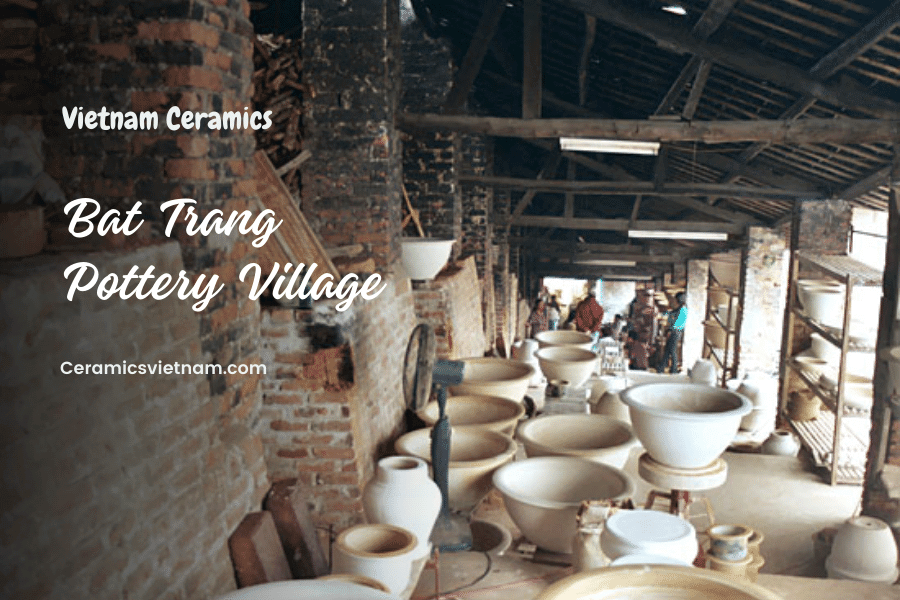
Bat Trang Pottery Village in the heart of Hanoi
The Relocation of the Capital
The relocation of the capital during the Ly Dynasty had a profound impact on Bat Trang Village, shaping its development into a renowned center for ceramic and pottery craftsmanship.
Impact of King Ly Cong Uan’s Decision on Bat Trang Village
King Ly Cong Uan’s decision to relocate the capital from Hoa Lu to Thang Long (present-day Hanoi) in the 11th century brought about significant changes throughout the region. The establishment of the new capital created opportunities for economic growth and cultural development. As Thang Long expanded, it attracted a diverse array of businessmen, craftsmen, and artisans seeking new prospects and opportunities.
Bat Trang Village, with its proximity to the capital, became an attractive destination for those looking to establish themselves in the burgeoning city. The village’s rich resources of white clay and its strategic location so it is considered as an ideal place for potters and ceramic craftsmen to settle. Artisans from various regions flocked to Bat Trang, bringing with them their expertise, techniques, and artistic traditions.
Migration of Artisans and Craftsmen to the Village
The migration of skilled artisans and craftsmen to Bat Trang Village played a pivotal role in its transformation into a center for ceramic and pottery production. These individuals brought with them their knowledge, honed skills, and regional artistic influences. They set up workshops, built kilns, and began creating pottery and ceramics using the abundant white clay found in the area.
The influx of artisans from different backgrounds and regions led to the exchange of ideas, techniques, and artistic styles. The village became a melting pot of creativity and innovation, with artisans continuously refining their craft and pushing the boundaries of ceramic and pottery production.
Development of Bat Trang as a Ceramic and Pottery Center
Over time, Bat Trang Village flourished and gained prominence as a hub of ceramic and pottery craftsmanship. The collective expertise of the artisans, combined with the village’s favorable geographical location, contributed to the development of specialized techniques and distinctive styles unique to Bat Trang.
As Bat Trang’s reputation grew, its ceramic products gained recognition for their exceptional quality, intricate designs, and vibrant glazes. The village became known not only within Vietnam but also internationally, attracting attention and demand for its exquisite ceramics from markets abroad.
Today, Bat Trang stands as a testament to its history and the legacy of the artisans who settled there. The village’s ceramic and pottery products continue to showcase the rich artistic traditions and craftsmanship that have been passed down through generations.
In conclusion, the relocation of the capital during the Ly Dynasty brought about a significant transformation in Bat Trang Village. The migration of skilled artisans and craftsmen, drawn by the opportunities presented by the capital’s relocation, turned Bat Trang into a center for ceramic and pottery production. The village’s rich history and the convergence of artistic talents contributed to the development of unique styles and techniques that have become synonymous with Bat Trang’s ceramic craftsmanship. Today, the village stands as a testament to its rich heritage and the enduring legacy of its artisans.
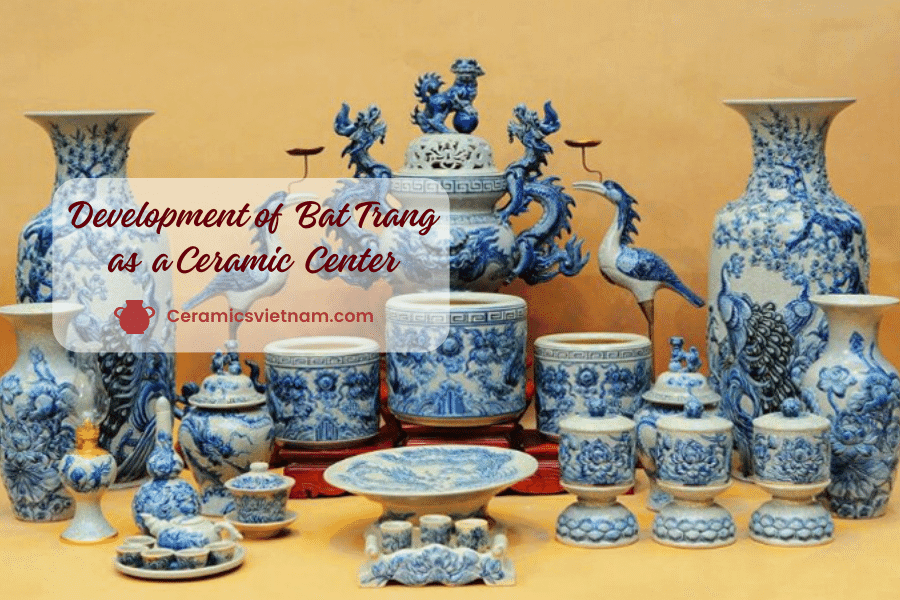
Bat Trang Pottery Village in the heart of Hanoi
The Art of Ceramic and Pottery Craftsmanship in Bat Trang
The Meticulous Production Process
The production process in Bat Trang Village involves a series of meticulous steps, each carefully executed to ensure the creation of exceptional ceramic and pottery pieces.
Step 1: Clay Selection and Preparation
The process begins with the selection of the finest clay, a crucial element in producing high-quality ceramics. Artisans in Bat Trang have a deep understanding of the characteristics and properties of different types of clay. They carefully choose the appropriate clay based on the desired final product and its specific requirements.
Once the clay is selected, it undergoes a thorough preparation process. It is cleaned, purified, and finely ground to remove impurities and achieve a smooth texture. This prepares the clay for the next step of the production process.
Step 2: Shaping and Molding the Clay
In this step, the artisans shape and mold the prepared clay into the desired form. Using their skilled hands, they carefully shape the clay, bringing their artistic vision to life. Traditional techniques such as hand molding or wheel throwing are employed, depending on the complexity and design of the piece.
During this stage, the artisans pay meticulous attention to detail, ensuring precise proportions and symmetry. They use specialized tools to refine the shape and texture of the clay, creating smooth surfaces and intricate details.
Step 3: Decoration and Glazing Techniques
Once the clay has been shaped and molded, it is time to adorn the piece with decorative elements and apply glazes. This is where the artistry and creativity of Bat Trang artisans truly shine.
Artisans employ various decoration techniques, including hand-painting, carving, etching, and embossing. These techniques allow them to add intricate patterns, motifs, and designs that reflect the cultural heritage and artistic traditions of Bat Trang Village.
Glazing is another essential aspect of the decoration process. Artisans carefully select and apply glazes to enhance the visual appeal of the ceramic piece. Glazes not only add color but also provide a protective coating, ensuring durability and resistance to moisture.
Step 4: Firing and Kiln Processes
After decoration and glazing, the ceramic pieces are fired in kilns, a critical stage in the production process. The firing process transforms the raw clay into a durable, finished ceramic product.
Artisans load the pieces into the kiln, carefully arranging them to ensure even heat distribution. The firing temperature and duration are precisely controlled, based on the type of clay and desired results. The kilns reach high temperatures, ranging from 1,200 to 1,300 degrees Celsius, depending on the specific requirements of the piece.
The firing process takes several days and nights. During this time, the intense heat causes chemical reactions within the clay and glazes, resulting in a hardened and beautifully glazed ceramic piece. After the firing is complete, the kiln is gradually cooled before the finished products are carefully removed.
In brief, the meticulous production process in Bat Trang Village showcases the craftsmanship and attention to detail that goes into creating exquisite ceramic and pottery pieces. From clay selection and preparation to shaping, decoration, and firing, each step is carefully executed by skilled artisans. The result is a collection of stunning ceramics that embody the rich artistic traditions and heritage of Bat Trang Village.
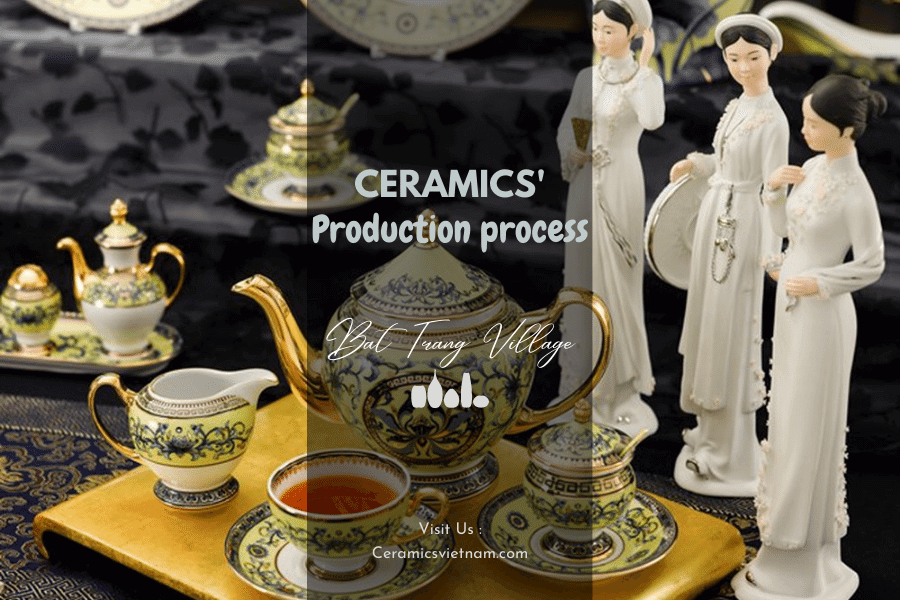
Bat Trang Pottery Village in the heart of Hanoi
Mastering Traditional Techniques
Bat Trang Village takes pride in preserving traditional ceramic techniques, with skilled artisans playing a crucial role in upholding these time-honored methods.
Handmade vs. Mass-Produced Ceramics
In an era of mass production, Bat Trang Village stands as a testament to the enduring beauty and value of handmade ceramics. Unlike mass-produced ceramics, which prioritize efficiency and uniformity, Bat Trang artisans meticulously handcraft each piece, infusing it with a unique character and individuality.
Handmade ceramics allow for greater attention to detail and artistic expression. Skilled artisans in Bat Trang use their expertise, honed over years of practice, to create pieces that showcase the finest craftsmanship and reflect the rich cultural heritage of the village. The imperfections and slight variations that come with handmade ceramics contribute to their charm and authenticity, making each piece truly one-of-a-kind.
The Role of Skilled Artisans in Preserving Traditional Methods
Skilled artisans are at the heart of Bat Trang’s preservation of traditional ceramic techniques. Through their dedication and expertise, they ensure that the legacy of the village’s traditional methods is carried forward.
These artisans have honed their skills through years of practice and dedication to their craft. They possess an intimate understanding of the materials, techniques, and tools required to create exceptional ceramics. By adhering to traditional methods, they uphold the authenticity and cultural significance of Bat Trang ceramics, allowing these traditions to thrive in a rapidly changing world.
Apprenticeships and Passing Down Ancestral Knowledge
One of the key ways in which traditional ceramic techniques are preserved in Bat Trang Village is through apprenticeships and the passing down of ancestral knowledge. Skilled artisans take on apprentices, often within their own families, to ensure that the craft is handed down from generation to generation.
These apprenticeships are characterized by a master-apprentice relationship, where the master imparts their knowledge, skills, and techniques to the next generation. Apprentices learn through observation, practice, and hands-on experience, gradually developing their own craftsmanship under the guidance of experienced artisans.
By maintaining this apprenticeship tradition, Bat Trang ensures the continuity of its traditional ceramic techniques. It allows for the transmission of ancestral knowledge and ensures that the intricate methods and artistic styles that define Bat Trang ceramics are preserved for future generations.
On the whole, the mastery of traditional techniques is central to the artistry and cultural significance of Bat Trang ceramics. Skilled artisans play a vital role in preserving these techniques, allowing the village to uphold its rich heritage and produce ceramics of exceptional quality. Through their dedication, craftsmanship, and the passing down of ancestral knowledge, Bat Trang artisans ensure that traditional methods continue to thrive, providing a link to the past and an enduring legacy for the future.
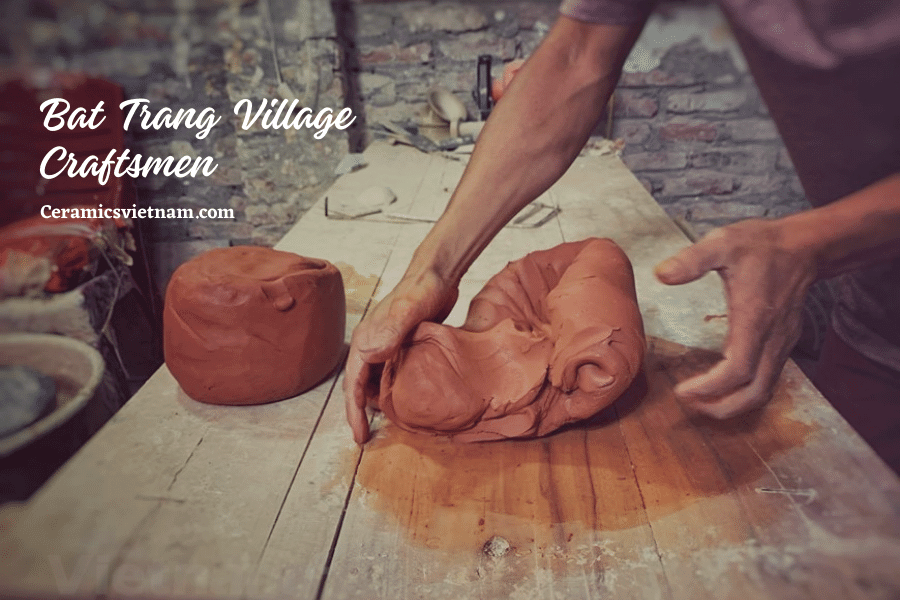
Bat Trang Pottery Village in the heart of Hanoi
The Diverse Range of Ceramic and Pottery Products
Utilitarian Wares: Functionality with Elegance
Bat Trang Village is renowned for its utilitarian wares, which seamlessly blend functionality with exquisite craftsmanship. From plates and bowls to teacups and kitchenware, these utilitarian ceramics elevate everyday objects into works of art.
Plates, Bowls, Teacups, and Kitchenware
Bat Trang artisans create plates, bowls, teacups, and various kitchenware items that are not only practical but also aesthetically pleasing. Plates and bowls come in a range of sizes and designs, catering to different culinary needs and serving requirements. These pieces often feature delicate patterns, intricate motifs, and vibrant glazes, transforming ordinary diningware into exceptional pieces of art.
Teacups, another staple of Bat Trang utilitarian wares, are designed with both functionality and elegance in mind. They are crafted to enhance the tea-drinking experience, with attention given to the ergonomics of the cup and the balance of its form. Bat Trang teacups often exhibit stunning hand-painted designs and smooth glazes, adding an extra element of beauty to tea ceremonies.
Kitchenware items, such as pitchers, mixing bowls, and serving dishes, showcase the versatility and practicality of Bat Trang ceramics. These pieces are designed for everyday use, with sturdy construction and durable finishes. Despite their utilitarian purpose, Bat Trang artisans infuse these kitchenware items with artistic flair, incorporating unique designs and patterns that elevate them from mere functional objects to decorative accents for the home.
Wine Bottles, Vases, and Flowerpots
Bat Trang utilitarian wares also extend to items used for decoration and display. Wine bottles, vases, and flowerpots are crafted with the same attention to detail and artistic sensibility as their functional counterparts.
Wine bottles from Bat Trang exhibit elegance and refinement. Their shapes are carefully crafted to enhance the experience of pouring and serving wine. The bottles often feature intricate hand-painted designs or relief patterns, adding a touch of sophistication to any dining or entertaining setting.
Vases and flowerpots from Bat Trang showcase the village’s artistic prowess. These pieces come in a variety of shapes and sizes, accommodating different floral arrangements and decorative preferences. Bat Trang vases and flowerpots often feature elaborate motifs, delicate sculptural details, and exquisite glazes, making them focal points in any space.
Unique Designs and Characteristics of Bat Trang Utilitarian Wares
What sets Bat Trang utilitarian wares apart are their unique designs and characteristics. The village’s artisans draw inspiration from various sources, including nature, mythology, and cultural heritage, to create distinctive patterns and motifs that adorn their ceramics.
Bat Trang utilitarian wares are known for their vibrant glazes, which range from serene blues and earthy browns to crisp whites and mossy greens. The glazes not only add visual appeal but also provide a protective coating, ensuring longevity and durability.
Moreover, the ceramics of Bat Trang possess a certain weight and thickness that sets them apart from their Chinese counterparts. This distinctive characteristic adds to their durability and functionality, making them suitable for everyday use.
In general, Bat Trang utilitarian wares offer a harmonious blend of functionality and elegance. Whether it’s plates and bowls for dining, teacups for tea ceremonies, or kitchenware for daily use, these ceramics embody the artistry and craftsmanship of Bat Trang Village. With their unique designs, vibrant glazes, and distinctive characteristics, Bat Trang utilitarian wares transform ordinary objects into extraordinary pieces that bring beauty and refinement to everyday life.

Bat Trang Pottery Village in the heart of Hanoi
Cult Wares: Treasures of Symbolism and Artistry
Bat Trang Village is renowned for its cult wares, which hold immense cultural significance and showcase the village’s intricate craftsmanship. From incense burners and candle holders to altar boxes and ceremonial objects, these cult wares are treasured for their symbolic meaning and artistic beauty.
Incense Burners, Candle Holders, and Religious Artifacts
Incense burners and candle holders play a vital role in religious and spiritual practices, and Bat Trang artisans create exquisite pieces that elevate these rituals. These wares are carefully crafted with attention to detail, reflecting both functionality and artistic expression.
Incense burners, designed to hold burning incense sticks, are adorned with intricate patterns and motifs. They often feature delicate carvings or relief work that symbolize spiritual beliefs and evoke a sense of tranquility and reverence. Bat Trang incense burners are not only functional but also serve as decorative objects, adding a touch of elegance and serenity to sacred spaces.
Candle holders, another significant aspect of cult wares, are crafted to hold candles used in religious ceremonies and rituals. Bat Trang candle holders exhibit unique designs and artistic flourishes, often incorporating religious symbols and motifs. These pieces are meticulously created to enhance the spiritual ambiance and provide a sense of illumination and serenity.
Religious artifacts, such as statues and religious figurines, are also part of Bat Trang’s cult wares. These pieces are crafted with great care, capturing the essence of deities and spiritual figures. They embody the devotion and reverence of the artisans, who skillfully bring the religious iconography to life through intricate sculpting and refined detailing.
Altar Boxes and Ceremonial Objects
Altar boxes and ceremonial objects are integral components of religious and ceremonial practices. Bat Trang artisans create stunning pieces that serve as focal points in sacred spaces, embodying the cultural and spiritual traditions of the village.
Altar boxes are intricately designed to store and display sacred objects, offering a place of reverence and devotion. These boxes often feature ornate carvings, gilded accents, and intricate motifs that reflect the religious beliefs and cultural heritage of Bat Trang.
Ceremonial objects, such as ritual swords, vessels, and instruments, are meticulously crafted with attention to detail. These objects are essential in religious ceremonies and traditional rituals, symbolizing power, spirituality, and cultural heritage. Bat Trang ceremonial objects exemplify the artistic mastery of the village’s artisans, showcasing their ability to infuse these objects with both aesthetic beauty and profound symbolic meaning.
The Cultural Significance and Intricate Craftsmanship of Bat Trang Cult Wares
Bat Trang cult wares hold deep cultural significance, representing the spiritual beliefs, traditions, and values of the community. The intricate craftsmanship of these wares reflects the dedication and skill of Bat Trang artisans, who meticulously carve, shape, and decorate each piece by hand.
The creation of cult wares requires a deep understanding of religious symbolism, cultural traditions, and the specific requirements of each object. Bat Trang artisans combine their technical expertise with artistic expression to bring forth pieces that are not only visually stunning but also imbued with spiritual significance.
These cult wares serve as a bridge between the physical and spiritual realms, embodying the devotion and reverence of those who use them. They hold a special place in the hearts of individuals and communities, carrying the legacy of Bat Trang’s cultural heritage and artistic excellence.
In other words, Bat Trang’s cult wares, including incense burners, candle holders, religious artifacts, altar boxes, and ceremonial objects, are treasures of symbolism and artistry. These exquisite pieces are not only functional but also hold deep cultural and spiritual significance.
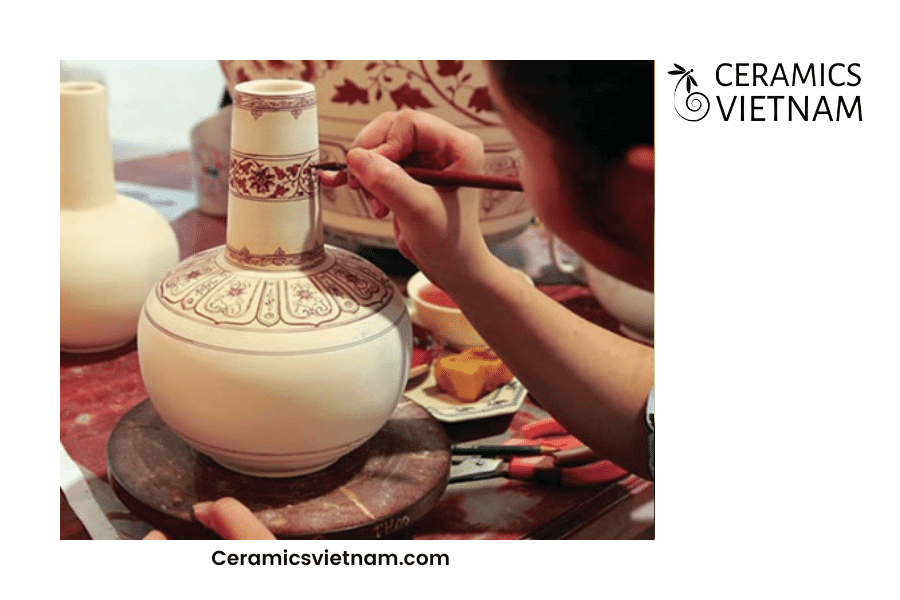
Bat Trang Pottery Village in the heart of Hanoi
Decorative Objects: Beauty in Every Detail
Bat Trang Village is renowned for its decorative objects, where beauty resides in every intricate detail. From statues and figurines to house models and architectural fixtures, these decorative pieces exemplify the unique designs and creative expressions of Bat Trang artisans.
Statues, Figurines, and Ornamental Pieces
Bat Trang artisans skillfully craft statues, figurines, and ornamental pieces that captivate with their artistic allure. These decorative objects are meticulously sculpted, reflecting a wide range of themes, from religious and mythological figures to animals, nature, and everyday life.
Statues and figurines portray deities, mythical creatures, and cultural icons, capturing the essence of their subjects with exceptional artistry. Each piece is carefully shaped and detailed, capturing intricate facial expressions, graceful poses, and delicate gestures. These decorative objects evoke a sense of spirituality, cultural heritage, and aesthetic appreciation.
Ornamental pieces serve as exquisite accents, enhancing the beauty of any space. Intricate carvings, relief work, and decorative motifs adorn these pieces, adding depth and visual interest. From ornate bowls and vases to delicate sculptures and wall hangings, Bat Trang artisans infuse these decorative objects with a unique artistic flair.
House Models and Architectural Fixtures
Bat Trang Village is also renowned for its house models and architectural fixtures, which offer a glimpse into the rich architectural heritage of Vietnam. These miniature replicas showcase the village’s mastery of design and attention to detail.
House models accurately represent traditional Vietnamese architectural styles, with intricate detailing that reflects the nuances of different periods and regions. From tiled roofs and carved wooden accents to ornate facades and structural elements, these models showcase the beauty and complexity of Vietnamese architecture on a smaller scale.
Architectural fixtures, such as decorative tiles, friezes, and ornamental elements, demonstrate the artistic excellence of Bat Trang artisans. These fixtures serve as exquisite embellishments for buildings, adding a touch of elegance and cultural charm. The intricate patterns, motifs, and designs reflect the artistic heritage and craftsmanship of Bat Trang Village.
Unique Designs and Creative Expressions in Bat Trang Decorative Objects
What sets Bat Trang decorative objects apart is the village’s commitment to unique designs and creative expressions. Each piece is a testament to the artistic imagination and technical skills of the artisans.
Bat Trang decorative objects often feature a diverse range of designs, from intricate floral patterns and geometric motifs to mythological symbols and scenes from daily life. The artisans draw inspiration from various sources, blending tradition with innovation to create visually stunning and thought-provoking pieces.
The creative expressions in Bat Trang decorative objects reflect the village’s rich cultural heritage and the artisans’ ability to infuse their work with personal touches and interpretations. These pieces not only serve as beautiful decorations but also as a representation of the artistic soul of Bat Trang Village.
In summary, Bat Trang’s decorative objects, including statues, figurines, ornamental pieces, house models, and architectural fixtures, are masterpieces that embody beauty in every intricate detail. The artistic expressions and unique designs of these decorative objects showcase the village’s rich cultural heritage and the exceptional craftsmanship of Bat Trang artisans. Whether depicting mythical figures, capturing architectural nuances, or adding artistic flourishes, Bat Trang’s decorative objects bring charm, beauty, and creative inspiration to any space.
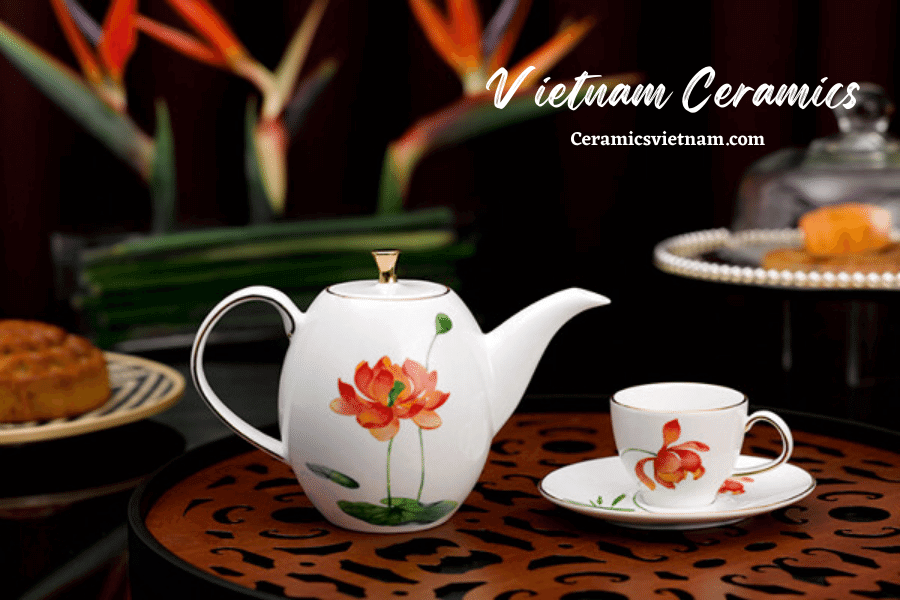
Bat Trang Pottery Village in the heart of Hanoi
Bat Trang’s Ceramic Craftsmanship and Global Reach
The Global Demand for Bat Trang Ceramics
Bat Trang ceramics have gained significant recognition and global demand, captivating collectors, enthusiasts, and international markets alike. The village’s exquisite craftsmanship and distinctive artistic style have propelled its ceramics to the forefront of the global stage.
Exports and International Markets
Bat Trang Village has established itself as a prominent exporter of ceramics, with its products finding their way to markets around the world. Through extensive trade networks and collaborations, Bat Trang ceramics have reached destinations far and wide, enchanting buyers and art lovers across continents.
Countries such as Japan, the Netherlands, Britain, Portugal, and various nations in Southeast Asia have become avid consumers of Bat Trang ceramics. These international markets recognize the exceptional quality, craftsmanship, and artistic value that Bat Trang artisans bring to their creations. The village’s ceramics have found their place in homes, galleries, and exhibitions, becoming a symbol of Vietnamese artistic excellence on a global scale.
The Appeal of Bat Trang Ceramics to Collectors and Enthusiasts
Bat Trang ceramics hold a particular allure for collectors and enthusiasts who appreciate the intricate beauty and cultural significance of these artistic creations. Each piece tells a story, embodying the heritage, traditions, and artistic expressions of Bat Trang Village.
Collectors are drawn to the uniqueness and authenticity of Bat Trang ceramics. The village’s dedication to preserving traditional techniques and its commitment to quality craftsmanship imbue these ceramics with a timeless charm that resonates with discerning collectors. The limited production and handcrafted nature of Bat Trang ceramics add to their desirability, making them coveted additions to private collections and art exhibitions.
Enthusiasts, on the other hand, are captivated by the artistic beauty and versatility of Bat Trang ceramics. The wide range of designs, styles, and forms cater to diverse tastes and preferences. From functional kitchenware to decorative objects, each piece showcases the village’s artistic prowess and reflects the unique cultural identity of Vietnam.
Establishing Bat Trang as a Global Brand
Bat Trang Village has embarked on a journey to establish itself as a global brand in the world of ceramics. With its rich heritage, exceptional craftsmanship, and growing international recognition, Bat Trang is steadily becoming synonymous with excellence in ceramic production.
Efforts are being made to promote Bat Trang as a destination for cultural tourism, attracting visitors who seek an immersive experience in the art of ceramics. The village’s artistic community, local authorities, and artisans collaborate to showcase Bat Trang’s rich cultural heritage and engage with a global audience. Exhibitions, workshops, and cultural exchanges further strengthen the village’s global presence, fostering connections and partnerships with artists and organizations worldwide.
As Bat Trang gains recognition as a global brand, it opens doors to new opportunities for the village’s artisans, further nurturing their creativity and sustaining the legacy of Bat Trang ceramics for generations to come.
Overall, the global demand for Bat Trang ceramics has propelled the village onto the international stage. With its exports reaching diverse markets and captivating collectors and enthusiasts worldwide, Bat Trang has become a symbol of Vietnamese artistic excellence. By establishing itself as a global brand, the village continues to preserve its heritage, promote cultural exchange, and ensure the sustained growth of its artisans.
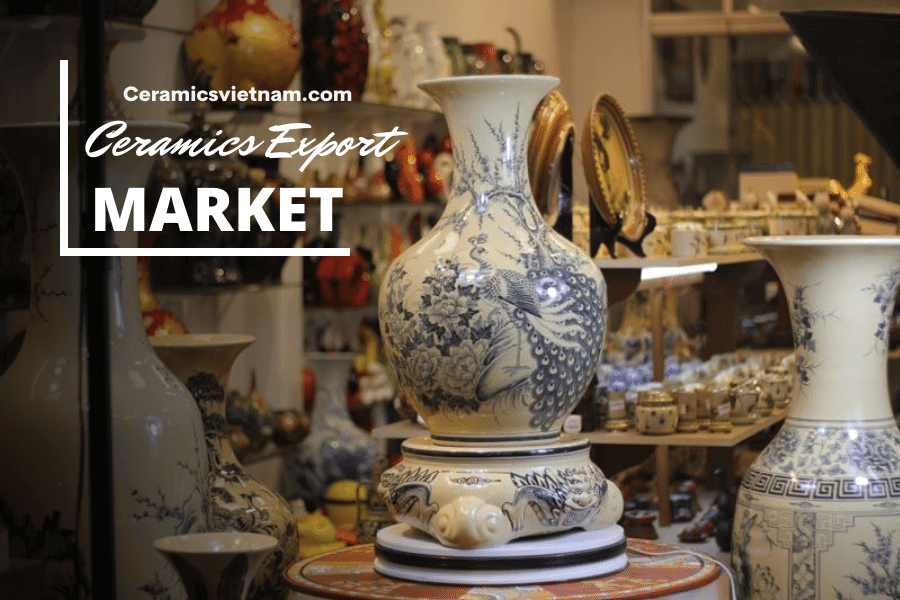
Bat Trang Pottery Village in the heart of Hanoi
Bat Trang as a Cultural and Tourist Destination
Bat Trang Village has emerged as a cultural and tourist destination, captivating visitors from around the world with its rich heritage, artistic traditions, and immersive experiences. The village’s renowned ceramics industry serves as a gateway for cultural tourism and promotes meaningful cultural exchange.
Attracting Visitors from Around the World
Bat Trang’s global reputation as a center for ceramic craftsmanship has drawn visitors from all corners of the globe. Art lovers, history enthusiasts, and cultural explorers flock to the village to witness firsthand the exceptional skills and artistic expressions of Bat Trang artisans.
Tourists are enchanted by the picturesque setting of Bat Trang, with its traditional houses, narrow streets, and bustling workshops. The village exudes an atmosphere of creativity and authenticity, offering a glimpse into the daily lives of artisans and the intricate processes involved in ceramic production. Visitors are captivated by the village’s charm, immersing themselves in its vibrant artistic heritage.
Cultural Tourism and Immersive Experiences in Bat Trang
Bat Trang Village offers immersive experiences that allow visitors to engage with the local culture and gain a deeper understanding of the ceramics industry. Guided tours provide insights into the history, techniques, and significance of Bat Trang ceramics. Visitors can explore workshops, witnessing skilled artisans at work and even try their hand at creating their own ceramic masterpieces under the guidance of experts.
Cultural tourism activities extend beyond ceramics, showcasing other aspects of the village’s heritage. Visitors can discover traditional Vietnamese architecture through house models and architectural displays. They can also engage in cultural performances, such as traditional music and dance, which further enrich the experience of Bat Trang as a cultural destination.
Promoting Cultural Exchange through Ceramics
Bat Trang’s ceramics industry serves as a catalyst for cultural exchange. Through workshops, exhibitions, and collaborations, the village fosters connections between local artisans and international artists, facilitating the exchange of ideas, techniques, and artistic inspiration.
Artists from around the world visit Bat Trang to learn from its master craftsmen, sharing their own artistic practices and perspectives. This cultural exchange not only enriches the artistic landscape of Bat Trang but also promotes cross-cultural understanding and appreciation.
By engaging in cultural exchange through ceramics, Bat Trang contributes to the preservation and promotion of global artistic heritage. The village serves as a meeting point for diverse artistic traditions, creating a platform for dialogue, learning, and mutual inspiration.
It can be seen that Bat Trang Village has transformed into a cultural and tourist destination, attracting visitors from all corners of the world. Through cultural tourism initiatives and immersive experiences, visitors gain a deeper appreciation for the village’s artistic heritage and the intricate processes involved in ceramic production. The village’s ceramics industry serves as a catalyst for cultural exchange, fostering connections and promoting cross-cultural understanding. Bat Trang’s efforts in promoting cultural tourism and engaging in cultural exchange through ceramics contribute to the preservation and promotion of global artistic heritage, ensuring the village remains a vibrant hub of creativity and cultural significance for years to come.

Bat Trang as a Cultural and Tourist Destination
Challenges and Sustainability of Traditional Craftsmanship
Modern Challenges and Innovations
Bat Trang Village faces modern challenges in the ever-evolving world of ceramics, including competition from modern technologies and mass production. However, the village also embraces innovation while balancing its rich tradition, opening up new markets and opportunities.
Competition from Modern Technologies and Mass Production
In today’s digital age, the ceramics industry faces competition from modern technologies and mass production methods. Automated processes and machinery have revolutionized production, enabling large-scale manufacturing with efficiency and cost-effectiveness. This presents a challenge for traditional ceramic artisans, who emphasize handcrafted techniques and the preservation of cultural heritage.
Bat Trang artisans recognize the need to adapt to changing times while maintaining the essence of their craft. They strive to find a balance between traditional techniques and modern technologies, leveraging advancements such as digital design tools, electric kilns, and efficient production processes. This allows them to streamline production while still infusing their ceramics with the unique artistry and cultural significance that distinguish Bat Trang creations.
Balancing Tradition with Innovation
The artisans of Bat Trang Village navigate the delicate balance between tradition and innovation. While honoring centuries-old techniques and cultural heritage, they also explore new creative expressions, materials, and designs.
Innovation in Bat Trang ceramics encompasses a range of aspects. Artisans experiment with new glazing techniques, exploring innovative ways to achieve unique colors, textures, and finishes. They collaborate with contemporary artists, architects, and designers to infuse fresh perspectives into traditional forms. Additionally, artisans seek inspiration from global artistic trends, blending tradition with contemporary aesthetics to appeal to a broader audience.
By embracing innovation, Bat Trang artisans ensure the continued relevance of their craft while preserving the distinctive artistic traditions that have defined the village for generations.
Embracing New Markets and Opportunities
Bat Trang Village recognizes the importance of expanding into new markets and embracing opportunities beyond its traditional customer base. The village actively seeks to promote its ceramics on a global scale, reaching discerning customers, collectors, and enthusiasts worldwide.
Through participation in international trade fairs, exhibitions, and online platforms, Bat Trang artisans showcase their creations to a diverse global audience. This exposure helps to open doors to new markets and collaborations, creating opportunities for growth and sustainability.
Bat Trang also seeks to diversify its product offerings, exploring new product lines, and expanding beyond traditional ceramics. This strategic approach allows the village to tap into emerging trends and cater to a wider range of consumer preferences, expanding its reach and securing its position in the global ceramics market.
On the whole, Bat Trang Village faces modern challenges in the form of competition from modern technologies and mass production. However, the village responds with resilience, finding innovative ways to balance tradition with innovation. By embracing new technologies, exploring creative expressions, and venturing into new markets, Bat Trang artisans ensure the continued relevance and sustainability of their craft. Through this adaptability, the village continues to thrive, preserving its cultural heritage while embracing the opportunities of the modern world.
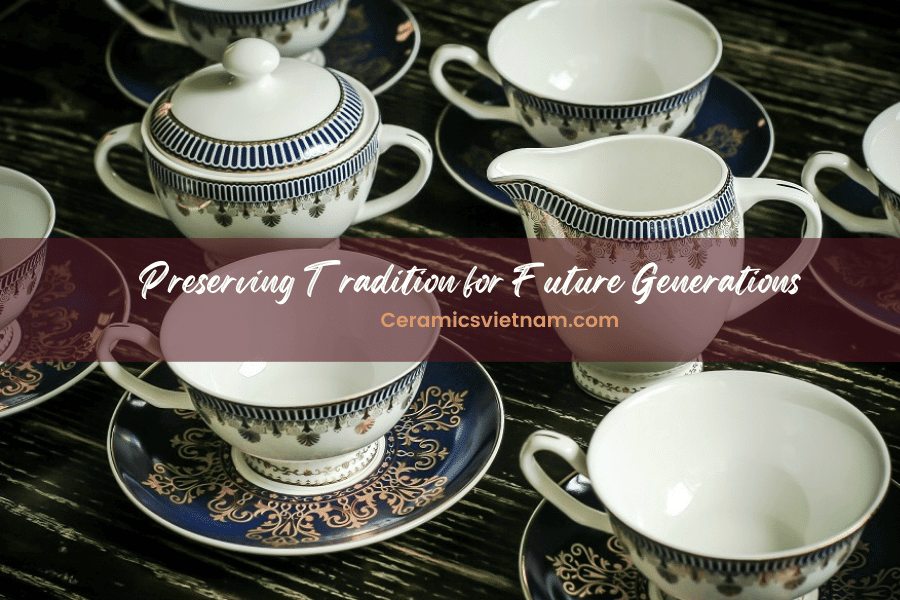
Bat Trang Pottery Village in the heart of Hanoi
Preserving Tradition for Future Generations
Bat Trang Village is committed to preserving its rich tradition for future generations. Through education, apprenticeships, government support, and community involvement, the village safeguards its cultural heritage and ensures the continuation of its esteemed ceramic craftsmanship.
Education and Apprenticeships in Ceramic Craftsmanship
Education plays a vital role in preserving Bat Trang’s ceramic tradition. The village encourages young artisans to pursue education and training in ceramic craftsmanship, providing them with the knowledge and skills necessary to carry on the legacy.
Apprenticeships are a cornerstone of Bat Trang’s educational approach. Established artisans take on apprentices, passing down ancestral knowledge, techniques, and craftsmanship from one generation to the next. Through hands-on experience, apprentices learn the intricacies of shaping clay, applying glazes, and firing ceramics, ensuring the continuity of the village’s traditional methods.
By nurturing a new generation of skilled artisans, Bat Trang secures the future of its ceramic tradition, allowing it to thrive and evolve while staying true to its roots.
Government Support and Initiatives for Cultural Preservation
The Vietnamese government recognizes the importance of cultural preservation and actively supports initiatives aimed at safeguarding Bat Trang’s heritage. Various programs and policies are in place to ensure the long-term preservation of the village’s artistic traditions.
Financial support, grants, and subsidies are provided to artisans, workshops, and cultural organizations to encourage the continuation of traditional ceramic craftsmanship. This support enables artisans to sustain their practices, invest in equipment and materials, and pass on their knowledge to future generations.
Additionally, the government collaborates with Bat Trang Village to develop and implement cultural preservation projects. These projects focus on documenting the village’s history, promoting cultural tourism, and organizing events and exhibitions that celebrate Bat Trang’s ceramic heritage.
The Role of the Community in Safeguarding Bat Trang’s Heritage
The Bat Trang community plays a vital role in safeguarding the village’s heritage. The collective efforts of residents, artisans, and local organizations ensure the preservation of cultural traditions and the sustainability of the ceramic industry.
Community engagement initiatives foster a sense of pride and belonging among villagers. Workshops, seminars, and cultural events are organized to educate both locals and visitors about the significance of Bat Trang’s ceramic heritage. The community actively participates in these events, sharing their knowledge and experiences, and promoting the village’s cultural identity.
Collaborative efforts between artisans and the community create a supportive environment for the preservation of Bat Trang’s heritage. This collective spirit ensures that the values, techniques, and artistic expressions of the village are cherished and passed on from one generation to another.
Hence, Bat Trang Village’s commitment to preserving its tradition for future generations is evident through education, apprenticeships, government support, and community involvement. By nurturing young artisans, encouraging educational opportunities, and providing financial assistance, Bat Trang ensures the continuity of its esteemed ceramic craftsmanship.
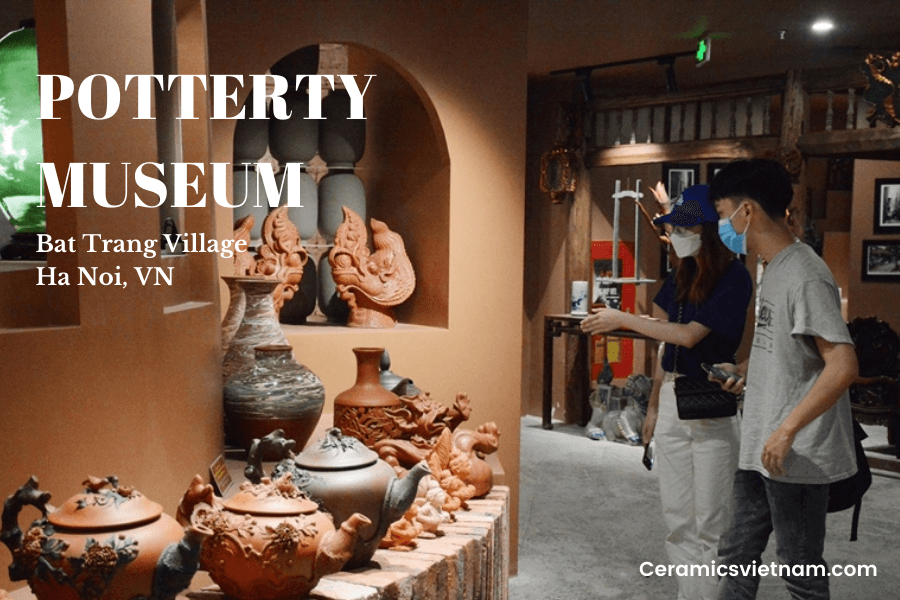
Bat Trang Pottery Village in the heart of Hanoi
Conclusion
Bat Trang Village stands as a testament to the enduring beauty and significance of traditional ceramic and pottery craftsmanship. With its rich history, meticulous production process, diverse range of products, and commitment to cultural preservation, Bat Trang continues to captivate and inspire. As the village adapts to modern challenges, it remains dedicated to sustaining its legacy for future generations, ensuring that the art of Bat Trang ceramics continues to flourish for years to come.
FAQs
- What is the best time to visit Bat Trang Village? The best time to visit Bat Trang Village is during the dry season, from October to April, when the weather is pleasant and rainfall is minimal.
- Are there any guided tours available in Bat Trang Village? Yes, guided tours are available in Bat Trang Village. These tours provide insights into the village’s history, the ceramic-making process, and allow visitors to interact with artisans.
- Can visitors try their hand at pottery making? Absolutely! Visitors can participate in pottery classes and try their hand at pottery making. It’s a fun and interactive way to learn about the craft and create your own ceramic masterpiece.
- What are some popular ceramic products from Bat Trang Village? Bat Trang Village is renowned for its ceramic tableware, including bowls, plates, tea sets, and vases. Decorative items such as sculptures and figurines are also popular choices.
- How do I get to Bat Trang Village from Hanoi? Bat Trang Village is located approximately 13 kilometers from Hanoi. You can easily reach the village by taking a taxi, bus, or joining a guided tour from Hanoi.














Leave a reply